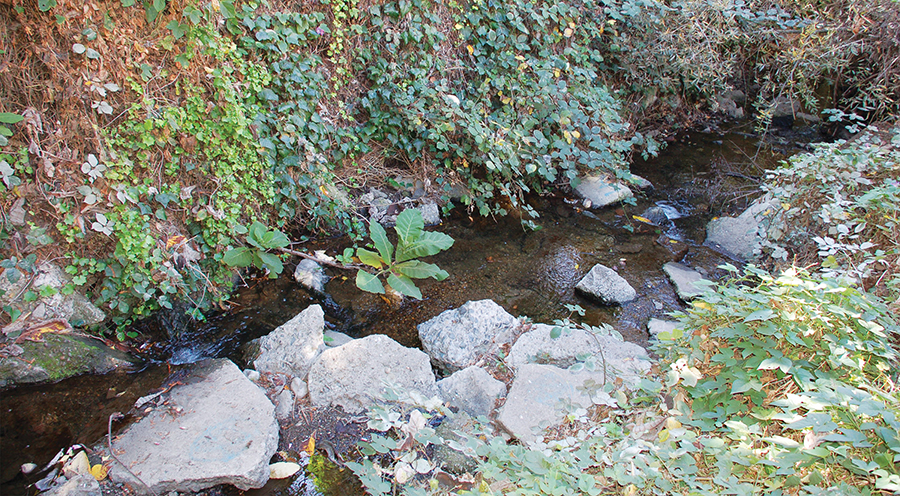
Experts consider the daylighting of Strawberry Creek in Berkeley to be a pioneering example of such projects. Photo by Alec MacDonald.
Stroll through just about any of the cities ringing the San Francisco Bay and you’re likely walking on water. Not literally, of course. Rather, chances are that somewhere along your way, there’s a stream running beneath your feet. As land around the Bay was developed, creeks were rerouted underground through pipes called culverts for flood protection. But in some spots, these hidden waterways can be brought back up to the surface to provide habitat for wildlife and respite for people.
The Bay Area is a national leader in this type of restoration, which is aptly called daylighting. And now we’re undertaking our most ambitious such project yet. The East Bay Regional Park District (EBRPD) is about to daylight more than half a mile of Alder Creek in Robert Sibley Volcanic Regional Preserve, near Pinehurst Road in the Oakland hills.
“The creek there is almost all underground; it looks like a meadow,” said Matt Graul, EBRPD’s chief of stewardship. “The site was used as a quarry and they culverted the stream so they didn’t have to deal with road flooding.” The new daylighting project is part of an effort to restore four acres of the preserve, which will also include reestablishing riparian plants along the daylighted stretch of creek as well as new trails and a group camp site.
When the park district acquired the property eight years ago, they wanted to open it up for hiking. But the land around the buried creek was unstable. “It hadn’t been engineered properly and the culverting began to fail,” Graul said. Water escaped, eroding sinkholes and gullies as deep as 25 feet. “It was dangerous — if you started stomping around, you might fall in.” This spurred the district to fast-track Alder Creek’s daylighting.
Rainbow trout stand to benefit hugely. These native fish live in San Leandro Creek, which Alder Creek flows into. But they can’t swim into Alder Creek due to the culverting, so they just collect in a large pool that forms just below the pipe. “The trout want to come up,” Graul explained. “The upper watershed is good spawning habitat.” Restoring Alder Creek will also help threatened and endangered species by, for example, providing habitat for California red-legged frogs as well as prey for Alameda whipsnakes and golden eagles.
The project will go out to bid early next year and the total cost, including planning and permitting, is estimated to be roughly $11.5 million. Graul expects the construction phase to be complete within two years. “It’s extremely exciting,” he said. “There’s just something about flowing water. I’ve loved being around streams and creeks since childhood.”
Daylighting creeks is widely embraced these days. But the concept was quite controversial when initially proposed in 1982 for Berkeley’s Strawberry Creek, one of the earliest known daylighting projects in the country. “It was seen as a wacko, dangerous, fringe idea,” recalled Ann Riley, cofounder of the Urban Creeks Council, a Berkeley-based nonprofit dedicated to stewardship of Bay Area streams. “There were worries about endangering children.” City officials also feared that bringing the creek above ground again would cause trash buildup and flooding.
Strawberry Creek runs freely through much of the UC Berkeley campus and then disappears underground, generally paralleling University Avenue until reaching the Bay. The city’s concerns notwithstanding, community activists prevailed and the stream now resurfaces in Strawberry Creek Park, where a 200-foot section was daylighted in 1984.
“The Strawberry Creek project is widely considered the archetype of daylighting,” according to a year 2000 Rocky Mountain Institute report called Daylighting: New Life for Buried Streams. “It inspired many other projects.” While buried creeks have been re-exposed here and there around the country, the practice really took off in the Bay Area.
Riley rapidly ticked off a dozen or so local projects, including a recent one at Cerrito Creek that illustrates the turnaround in institutional perceptions of daylighting. Instead of voicing objections, as the City of Berkeley did in the early 1980s, the City of El Cerrito actually required re-exposing a 180-foot stretch of the creek as a condition for developing an apartment complex adjacent to the El Cerrito Plaza shopping center. “There’s been a huge political attitude change,” said Riley, who chronicles this evolution in her 2016 book Restoring Neighborhood Streams. “It really is remarkable.”
To raise awareness of the Bay Area’s many creeks, in the early 1990s the Oakland Museum of California began mapping Bay Area creeks both above and below ground. “They wanted maps that people could carry around to find their creeks,” said Janet Sowers, a geologist at Fugro Consultants, a Walnut Creek-based environmental engineering firm, who has worked on the project since the very beginning.
The first map covered Oakland and Berkeley, tracing the meandering paths of historical creeks as well as their highly-altered modern routes. “Creeks still flow from the hills to the Bay, so it’s still a watershed,” Sowers said. “But in general, there is more underground stormdrain network than original creek network.”
Free-flowing creeks are depicted in blue while culverted waterways are in gold. The City of Berkeley, for example, has a scattering of blue squiggles but is dominated by straight gold lines that show where water is shunted underneath the city and down to the Bay. “The map was so popular we kept going,” Sowers said. “We now have 17 maps around the Bay.” Creek maps are available from the Oakland Museum store, and there is also an online Google Earth version for Alameda County.
Major funding for the creek mapping project came from the Alameda County Flood Control and Water Conservation District, and the Santa Clara Valley Water District. The motivation, Sowers explained, was to reduce water pollution. Knowing about the waterways around — and below — us could instill mindfulness of the connections between our actions and ecological health. For example, people contaminate streams with excess fertilizer and pesticides from gardens as well as oil and other toxic chemicals from streets. “If citizens are more informed and engaged, they are more likely to be good stewards of creeks,” Sowers said.
Robin Meadows covers water for the Monitor.

